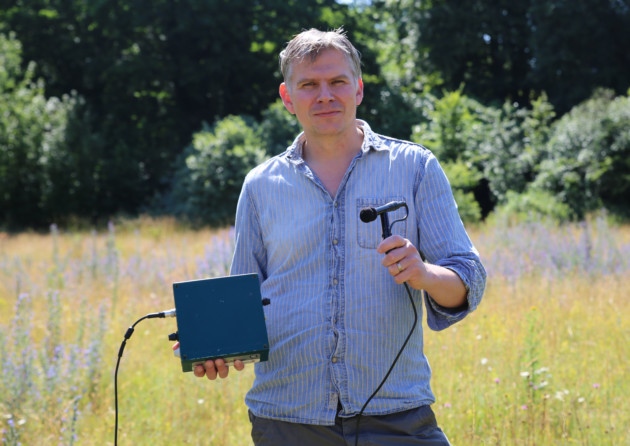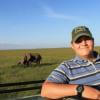Acoustic sensors enable efficient and non-invasive monitoring of a wide range of species, including many that are difficult to monitor in other ways. Although they were initially limited in application scope largely due to cost and hardware constraints, the development of low-cost, open-source models like the Audiomoth in recent years has increased access immensely and opened up new avenues of research. For example, some teams are using them to identify illicit human activities through the detection of associated sounds, like gunshots, vehicles, or chainsaws (e.g. OpenEars).
With this relatively novel dimension of wildlife monitoring rapidly advancing in both marine and terrestrial systems, it is crucial that we identify and share information about the utility and constraints of these sensors to inform efforts. A recent study identified advancements in hardware and machine learning applications, as well as early development of acoustic biodiversity indicators, as factors facilitating progress in the field. In terms of limitations, the authors highlight insufficient reference sound libraries, a lack of open-source audio processing tools, and a need for standardization of survey and analysis protocols. They also stress the importance of collaboration in moving forward, which is precisely what this group will aim to facilitate.
If you're new to acoustic monitoring and want to get up to speed on the basics, check out these beginner's resources and conversations from across the WILDLABS platform:
Three Resources for Beginners:
- Listening to Nature: The Emerging Field of Bioacoustics, Adam Welz
- Ecoacoustics and Biodiversity Monitoring, RSEC Journal
- Monitoring Ecosystems through Sound: The Present and Future of Passive Acoustics, Ella Browning and Rory Gibb
Three Forum Threads for Beginners:
- AudioMoth user guide | Tessa Rhinehart
- Audiomoth and Natterjack Monitoring (UK) | Stuart Newson
- Help with analysing bat recordings from Audiomoth | Carlos Abrahams
Three Tutorials for Beginners:
- "How do I perform automated recordings of bird assemblages?" | Carlos Abrahams, Tech Tutors
- "How do I scale up acoustic surveys with Audiomoths and automated processing?" | Tessa Rhinehart, Tech Tutors
- Acoustic Monitoring | David Watson, Ruby Lee, Andy Hill, and Dimitri Ponirakis, Virtual Meetups
Want to know more about acoustic monitoring and learn from experts in the WILDLABS community? Jump into the discussion in our Acoustic Monitoring group!
Header image: Carly Batist
IMOS Animal Tracking Facility is hiring a Technical Officer to assist with the preparation, deployment and maintenance of acoustic receivers to monitor movements of tagged animals & continue to develop operational...
7 February 2023
Are you excited by the potential for new technologies to help monitor the natural world? Do you enjoy communicating your passion for technology and nature with diverse audiences? We are seeking an enthusiastic...
2 February 2023
Consultancy opportunity at ZSL for an experienced monitoring specialist to support species monitoring in rewilding landscapes across Europe
31 January 2023
Are you stuck on an AI or ML challenge in your conservation work? Apply now for the chance to receive tailored expert advice from data scientists! Applications due 27th January 2023
18 January 2023
WILDLABS and Fauna & Flora International are seeking an early career Vietnamese conservationist for 12-month paid internship position to grow and support the Southeast Asia regional community in our global...
11 January 2023
To assist with creative research project in the DC/VA/MD region
6 January 2023
Careers
We are looking for someone who enjoys the craft of making to come and help run our London based lab.
5 January 2023
a technology-led solution to understanding the honeybees of the wasp world
8 December 2022
Five articles that include conservation tech published at Mongabay
20 October 2022
*New closing date!* WILDLABS and Fauna & Flora International are seeking an early career conservationist for 12-month paid internship position to grow and support the Southeast Asia regional community in our global...
19 October 2022
The Institute for Bird Populations (IBP) seeks a biologist to assist with an autonomous recording unit (ARU) bird monitoring project at California off-highway vehicle recreation parks and other ARU monitoring projects...
19 October 2022
June 2024
July 2024
event
September 2024
event
October 2022
July 2021
December 2020
Group purchase of the AudioMoth from Open Acoustic Devices imminent
16 April 2017 1:32am
6 December 2017 6:55pm
Hi everyone,
Good news! The second group purchase is going live this week. We've been preparing things with GroupGets to get it live, so I'll post the link to the campaign for those who want to get their hands on a device. I may start a new thread for the second round as this one is getting a tad long.
@nilaksha - do you have a specific frequency range you'd like to target in regards to your elephant research? The AudioMoth may already be capable if you can let us know your target.
6 December 2017 8:15pm
Good news indeed, Al! I think a new thread is definitely a good idea - this one is getting rather unwieldy.
@nilaksha, you might check out @Jan+Kees 's serval sensor thread as well, as he's working on elephant recordings so it could be of interest. It's over here.
Cheers,
Steph
Acoustics for Human-Wildlife Conflict Prevention, Anti-poaching, and more
27 April 2017 5:28pm
2 November 2017 2:20pm
Hi Chris,
thx for sharing your ideas. We indeed cracked the problem of recognitizing sound types and to deploy a trained convolutional network model on a RPi. The information we process includes dB-levels per audio band, thus, yes, that is also possible on a RPi.
The current version of the sensor can 'talk' LoRa and GPRS, but that was the easy part. If necessary, we can install a local LoRa-network. We have our own one running around our office.
Power consumption is the actually the limiting factor in terms of for which problems you can or cannot apply the SERVAL technology. We are developing it to mitigate HWC-situations, as these are by definition within the zone between nature and culturalized land. Power is less of a problem in these zone, because we can detect elephant rumbles and tiger roars on several km's distance.
Thus, the sensor is ready, but the data processing and learning is not. At this moment we are searching for funds or volunteers to help us process the recordings. Once that work is completed, we are ready for the field ;-)
2 November 2017 4:16pm
sign me up as a volunteer!
:-]
Being a Cornell grad, I have a Raven Pro license.
agreed, power is everything. Again, with the GPU-accelerated FFTs, is it perhaps possible to run the algorithms on an RPI A, or perhaps even a Zero? Or is this done via Raven batch mode?
I'm quite interested to acoustically detecting human activity in general; i.e. trucks, motorcycles, gunshots, chainsaws, and with hydrophones, motorboats, but also collect/harvest vast amounts of data in super-remote places for TEAM, as per: http://www.teamnetwork.org/about , and generally target the SMART folks of: http://smartconservationtools.org/smart-partnership/ I'll be at the World Bank in a few weeks for: http://conferences.iaia.org/wdc2017/ , with the goal being to find a sponser to pilot this sort of thing for biodiversity monitoring.
(and while we're burning power, perhaps discriminating bipeds vs quadrupeds visually, as per: https://github.com/wzyuliyang/RaspberryHOG, https://www.pyimagesearch.com/2015/11/09/pedestrian-detection-opencv/ ..?)
Anyway, extremely good to find you.
How can I participate?
Chris
2 November 2017 5:03pm
Great. Let's continue our discussion that through Skype ;-) My skype name is jkschakel and you can email me at [email protected].
I'm available on Tuesday or Wednessday night (Amsterdam time) or Thursday. Could you please send me an email with your skype name and some cv or whatever for me to orientate?
To answer your other questions:
- Yes, we do use Raven (light) to extract the sound samples.
- No, we don't use raven on the RPi, and because it has to analyse sounds in realtime, the Zero is (currently) not powerful enough.
- crunshing and analysing the numbers is done on the RPi, but we bypass visualisation. The output is a numerical class (representing e.g. chainsaw, elephant at circa 1000m, etc) which is transmitted to the rangers.
- We certainly share our interests - let's see how we can join forces. We have cracked the techno aspects and know how to create the model, but have not yet found a sponsor to fund that labour. Help in terms of funds or hands-on time is highly appreciated!
HWC Tech Challenge Update: Meet the Judges
20 October 2017 12:00am
Imagery request
6 March 2017 11:55am
7 March 2017 11:09am
Amazing, thanks Arik!
15 March 2017 4:27pm
Hey Paul,
Emma and Paige have also given the go ahead to use their photos, they also have some other photos you might be able to use!
@WILDLABSNET Absolutely, I'd be more than happy to help. I've got lots of photographs from my acoustic monitoring projects. Thanks!
— Emma Checkley (@EmmaCheckley11) March 8, 2017
@WILDLABSNET Yeah, I've definitely got some of those lying around!
— Paige A. Byerly (@paigebyerly) March 8, 2017
16 October 2017 1:18pm
Paul,
Hi - is this still needed, as I'm sure we could provide something relating to birds, bats and cetaceans?
Thanks, Carlos
New R package: 'soundecology'
7 February 2017 3:17pm
16 October 2017 12:51pm
Steffen,
Thanks for that tip-off, I'd not seen that paper before. One of the speakers at my bird bioacoustics meeting in July covered soundscape ecology, with some interesting data comparisons of the different metrics. His presentation is on our website if you would like a copy?
Also, I've just emailed Danile Hayhow about the work on capercaillie I've been doing in 2016 & 2017- recording lekking calls to see if an activity index compares with standard survey methods. I'd be very keen to talk this over with yourselves at the RSPB in preparing the journal publication, as it will incorporate the survey data from 2017 collected by RSPB Scotland staff.
Thanks, Carlos
Download New Conservation Tech Guidelines: Camera Traps, Acoustics and LiDAR
 Paul Glover-Kapfer
Paul Glover-Kapfer
11 October 2017 12:00am
Describe Your Work in Six Words
13 September 2017 5:40pm
Elephant communication translation
14 August 2017 2:30pm
6 September 2017 10:47pm
Wow, this would be amazing to continue on with the years of data I have from tigers! I understand their social lives are very different but it would be interesting to see what other species could be highlighted on a platform like this.
Trialing Audiomoth to detect the hidden threats under the canopies of Belize
 Andrew Hill
Andrew Hill
27 June 2017 12:00am
Product Grant Program for Wildlife Acoustics hardware & software
12 June 2017 7:35pm
Wolf detector prototype
30 April 2016 2:10pm
23 May 2016 1:16pm
Hi Arik
Did you already test it with wolves?? I would be very interested in learning your results as I am preparing some accustic monitoring of wolves for my PhD.
keeping in touch
Nuno
23 May 2016 1:19pm
Hi Nuno,
Still working on the design, and in particular the microphone technology so that we can be confident of detecting animals at long range. Our current system using SM3s works well up to several kilometers.
Where are you planning to detect wolves? Will you be at CSF next month? We could talk more there. But keep an eye on this thread and I'll post updates.
Thanks,
Arik
5 June 2017 6:22pm
Hi guys, interesting discussion. As you may have read, we are developing an elephant-detector (to avoid HWC's). The technology we are using (neural networks) can also be used to learn to recognize wolves automatically. If you have wolf-sound samples for us, we can create a classifier to automatically process your recordings. Alternatively we may be able to run the classifier in real-time on a RPi. But like you mentioned above, power consumption is an issue. Maybe less so if we can mount the sensor on a street light with car battery or something. What do you think?
Comparing two sound wave files - for a conservation game
20 March 2017 8:59am
29 March 2017 8:46pm
Dynamic Time Warping is often used as a foundation.
30 March 2017 1:47am
Hey Gautam!
Could you share few sample files? I want to try out a couple algorithm and see if that's useful to you.
Thanks,
Bhavesh
7 April 2017 1:42pm
Hi Bhavesh - thanks a lot. WildLabs doesn't allow me to upload .wav files - can I email you or get them to you another way? They are small - 2 seconds each.
You can email me at [email protected]
Gautam!
#Tech4Wildlife Photo Challenge: Our favourites from 2016
1 March 2017 12:00am
Conservation Leadership Programme 2017 Award
21 November 2016 12:00am
Neotropical Migratory Bird Conservation Act grants via USFWS
8 November 2016 12:00am
Moonshots - Where will we be in five years?
7 October 2016 4:52pm
3 November 2016 9:05am
Hi Courtney,
sounds are indeed a very interesting theme. If you ask me, it is one of the most underestimated senses, especially when we are talking about wildlife protection. People tend to make quite a lot of noices that distinguish them from animals ;-)
I am working on a prototype 'soundscape sensor'. The basic idea is to record all sounds at a particular location and calculate a kind of 'normalised' sound. This summary can then be used to listen to sounds that deviate from that. Could be chainsaws, gun shots, car engines, talking people, barking dogs, whatever.
By feeding these sounds to rangers with local knowledge, or to a crowd (like Panthera is doing), the sensor's performance improves over time.
Although we think our first prototype will be ready by the end of this year (recognizing one particular sound within an outdoor environment), subsequent steps are quite challenging. Especially when more than one or two sounds occur at the same time.
If you ask me where we will be in the next few years, I would say:
2017: recognizing any trained sound within a given field context (using a Raspberry)
2018: learning to distinguish compounded sounds (using a backend server)
2019: idem, but then much more efficient, so we can run it on a Raspberry pi
Interested to help us to create this?
Cheers,
Jan Kees
3 November 2016 9:19am
My moonshot would be increased used of DSP in underwater acoustic monitoring, to enable small arrays to filter out engine noise to look for vocalisations; statis reflections of exiting noise sources, and doppler reflections too. Heavyweight DSP might be enough to gauge the size of objects and a useful distance estimate too…
3 November 2016 9:56am
sorry, double entry
Zoohackathon: 'END LOOP - Coding to end wildlife trafficking'
22 September 2016 12:00am
Choosing a Journal for Publication
8 June 2016 3:16pm
9 June 2016 5:38am
Hi Courtney,
Jason mentioned some very good journals (and there are many more) that cover broad areas of research as indicated by the journal titles. Perhaps your paper might fit into any of them.
However, people can give you more focussed recommendations if you tell us what research questions you addressed. At this point we only know what kind of technology you used.
Is technology itself the main topic of your paper? Or are you reporting what you learned about tiger biology/ecology through using accoustic technology?
Julia
27 July 2016 5:44pm
Hello Julia,
Apologies for the delay in response!
The objective of this study was to determine if unique acoustic patterns exist among Panthera tigris tigris individuals, and if sex (e.g. male vs. female) can be discriminated based on their vocalizations. We used Songmeter SM2's to record tigers then Raven Pro Analysis Software to analyze their vocalizations and identify which vocalization characteristics (e.g. min/max fundamental frequencies, call duration, etc) identified each tiger.
The study was to establish what vocal cues we could use for future acoustic monitoring networks for Panthera tigris in the wild.
Edit: I should also clarfiy this data was collected in ex-situ conditions with the implications of applying the gathered knowledge to in-situ conditions.
9 September 2016 2:30am
Hello Courtney
My turn to apologies for delay. Your study sounds very interesting and potentially a valuable technique for future in-situ research. Seems it could indeed fit journals with a broad scope concerning wildlife ecology and conservation (including those mentioned earlier in this thread) and not narrowly limited to accoustics. I hope you are progressing towards publishing your work and I look forwarrd to reading it!
Acoustic monitoring survey (WWF-UK)
14 June 2016 3:29pm
29 June 2016 9:42am
Hi Rory,
Thanks for sharing this survey - it'll be really interesting to hear what comes out of it. How are the results going so far? Has anything unexpected come up?
Cheers,
Steph
6 July 2016 10:44am
Hi Steph,
All's going well with the survey so far, thanks, though if anyone here has the time and inclination to share it further across their networks that'd be greatly appreciated - we've got quite a bit of feedback so far from members of the scientific community (and would like more!) but proportionally much fewer from the NGO/consulting sectors, which would also be really helpful.
That said, the results so far have been really useful. We've had some great, in-depth responses about experiences deploying acoustic equipment in a range of different environments, but also the responses have emphasised that many of the problems/challenges we've experienced in our lab group are common to almost everyone working in acoustic monitoring, regardless of environments/species of interest - the kind of info that's really useful for the report that will come out of this.
Cheers,
Rory
27 July 2016 5:43pm
Great survey idea, Rory! I am completing it for my organization now so you should see another form input shortly.
How can technology help us monitor those small cold-blooded critters that live in caves?
 Tony Whitten
Tony Whitten
25 July 2016 12:00am
Passive Acoustic Monitoring: Listening Out for New Conservation Opportunities
 Ammie Kalan
Ammie Kalan
29 June 2016 12:00am
Acoustic monitoring for locating wolf packs
26 March 2016 12:01am
13 April 2016 5:20pm
Greetings everyone,
I apologize for being somewhat absent in this thread as of late. But, I am very interested in this conversation regarding building a recorder with a decent localization platform (including the sound detection for gunshots!). If the discussion continues outside of this thread (i.e. an email chain), please include me in it as well! I can provide my email through private message.
13 April 2016 6:28pm
Hello all- When there are future updates with this project, please do continue to post them to this thread as it progresses. Thanks! The community would love to see updates.
24 June 2016 9:38am
For those who are interested in this thread, Arik has posted his new prototype in a new thread, where the discussion has continued.
Calculating species abundance from Acoustic Data
26 January 2016 1:22pm
26 April 2016 10:45am
Hi,
I think Steffen provided a good summary of the challenges.
IMO, the two most promising methods of estimating animal density from acoustic monitoring are the "generalised random encounter model" (gREM) and an extension of spatially-explicit capture-recapture (SECR). These potentially solve Steffen's problems 2 and 3, i.e. linking acoustic counts to abundance (2), and converting abundance to density (3).
gREM, although theoretically possible, may be tricky in practice (especially obtaining an estimate of how wide an animal's acoustic signal is). See here:
http://onlinelibrary.wiley.com/doi/10.1111/2041-210X.12346/abstract
SECR is potentially very powerful, but depends on an independent estimate of calling rate (a problem Yu Shiu rightly picked up on). I think this would be entirely possible for a species you can find and observe (e.g. a frog or common bird species), but difficult for lots of cryptic, low density species (e.g. tigers!, as Courtney mentioned). See here:
https://www.researchgate.net/publication/272371302_A_general_framework_for_animal_density_estimation_from_acoustic_detections_across_a_fixed_microphone_array
However, gREM and SECR do not help with Steffen's first point (1) "quantifying the number of vocalisations from a stream of acoustic recordings". Others might be able to advise on the best approaches there. Perhaps this is primarily a software / data processing problem...?
In terms of sampling design (as Mariane and Courtney were interested in), it depends what your aims are. For occupancy (which is not equal to abundance/density), similar design principles to camera-trapping are fair (but taking into consideration Yu Shiu's point that the effective sampling area might be MUCH larger for an acoustic sensor than a camera trap, so camera spacing will have to be larger too). For gREM, you can fairly flexible about sampling design (repeated detections of the same individual are not a problem), but your sensors should be set randomly in space (with respect to animal movement), not along trails etc. For SECR, you don't have to set your sensors randomly, but sensors must be close enough together for repeated detections of the same call in multiple sensors simultaneously (this design constrasts, therefore, with an occupancy design).
Hth,
Ollie
26 April 2016 11:59am
Hi Stephanie,
This is an interesting thread. For those interested in the topic, and forgive me for the blatant self-promotion of work, a Biological Reviews 2013 paper on the topic can be downloaded here http://www.creem.st-and.ac.uk/decaf/outputs. Additional case studies papers as well as a more general public paper in Acoustics Today are also available for download from the link. This link is the outputs page from project DECAF, dedicated to estimating animal density from passive acoustic fixed sensors, using cetaceans as case studies. The methods have been far more developed and used in the cetacean community, but I suspect a wider use in terrestrial environments will occur in the coming years. A key hurdle is perhaps the dynamics involved in acoustic cue rate production, but the issues will be much easier to tackle in terrestrial environments than in the marine environments we have been working on.
Hope this is helpful,
Tiago
26 April 2016 12:13pm
Hi Tiago,
Thank you for sharing this paper and contributing your experience to the thread. Blantant self promotion, as you put it, is more than welcome when the work you're pointing to is such a helpful resource!
Cheers,
Stephanie
Funding and Job Opportunities
26 November 2015 2:21pm
26 February 2016 3:26pm
The Elephant Listening Project at the University of Cornell is looking a Postdoctoral research to study forest elephants in central Africa using a combination of field observations and acoustic recordings. More info.
A novel citizen science approach for large-scale monitoring of bats
 Stuart Newson
Stuart Newson
5 February 2016 12:00am
Report outlines 2016's most pressing conservation issues
 Olivia Bailey
Olivia Bailey
3 February 2016 12:00am
Must-Have Books on Bioacoustics
31 January 2016 4:26pm
(News Article) Listening to the sounds of nature 24-7 in Alberta
31 January 2016 4:16pm
Ecological Acoustics (Ecological Informatics special issue)
29 December 2015 9:56pm























5 December 2017 10:01am
HI Alasdair,
pardon me if this is irrelevant, do you know any device which we can use to record low frequencies like sounds of elephants etc? I don't think AudioMoth is capable. I'm just trying to find such a device/technology.
kind regards!
Nilaksha